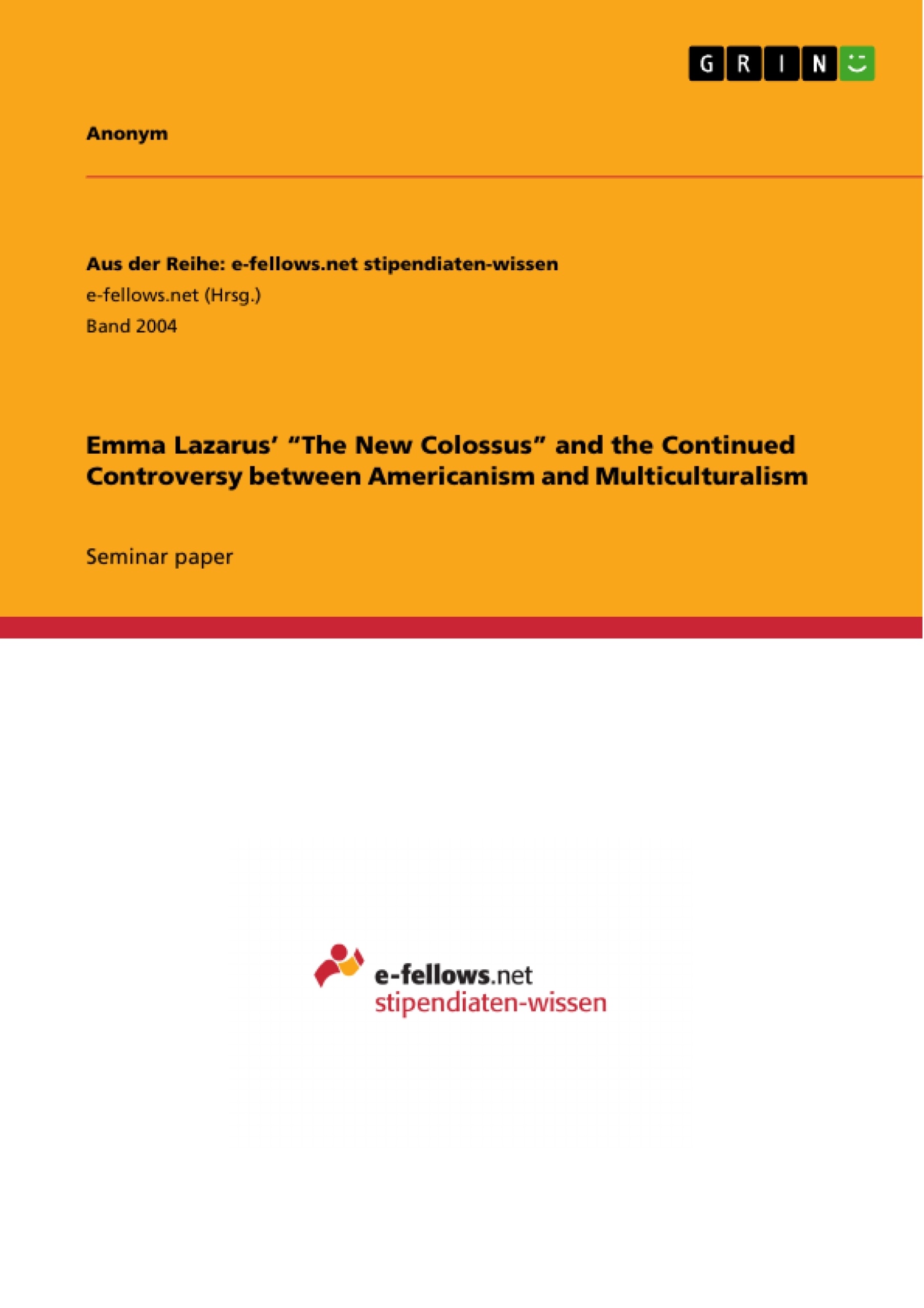Beginning with the interpretation and analysis of one of America’s probably most- cited and most well- known sonnets “The New Colossus” (1903) by Emma Lazarus, I will continue to explain its symbolic meaning throughout the 20th century until today and its significance in creating a commonly accepted national identity.
After briefly outlining the history of the different waves of immigrants between the early 19th century and the beginning of World War I that took on the hardships of several weeks of oversea travel to find their very own pursuit of happiness in the ‘New World’, and also the ones coming mostly from South and Middle America in the 21st century, I will show that the ‘nation of immigrants’ has also always been a nation of nativists. As an example of the once widespread belief in the supremacy of the white race and the predominance of Anglo- Protestant culture, I will compare and contrast Thomas Bailey Aldrichs’s poem “Unguarded Gates” (1895) to the opposing ideal of freedom, equality and openness that is proposed not only by Lazarus’ work, but also repeatedly emphasized in manifestations of the American Creed, such as the National Anthem or the Pledge of Allegiance.
Following Samuel P. Huntington’s question in “Who are we? The Challenges to America’s National Identity” (2004), I will then try to outline the phase of immigrants’ assimilation, as pictured by the Melting Pot metaphor, which was at that time challenged by the ‘tomato soup’ allegory and later replaced by the rising popularity of multiculturalism and the predominance of subnational identities over one’s national identity, best illustrated by the metaphor of a salad bowl.
The shock of September 11th however, again brought nationalist and patriotic feelings to the fore, causing not only a massive rise in restrictive immigration policies, such as the Patriot Act of 2002 or the Security Fence Act of 2006, but also raising questions concerning America’s future: will we see complete and thorough ‘hispanization’, the re-conquering of the state by Anglo- Protestant movements or rather the emergence of a bilingual society with two different cultures coexisting within one country? Is it even possible for America today to share a common national identity with only one language and only one dominant culture, while society is made up of so many different cultural sources?
Table of Contents
- I. Introduction.
- II The Statue of Liberty.
- II.1 Historical background.
- II.2 Symbolism.
- II.3 "The New Colossus".
- III Immigrants' reality
- III.1 Formation of Anglo- Protestant core culture
- III.2 Rise of anti- immigration sentiments.
- III.3 “Unguarded Gates\".
- IV Americanization versus multiculturalism..
- IV.1 Tomato soup, Melting Pot, Salad Bowl..
- IV.2 Rise of patriotism during World War II .
- IV.3 Deconstructionist Movement...
- V Influence of September 11th on American National Identity..
- V.1 Importance of National Identity over subnational identities ......
- V.2 Restrictions on immigration..
Objectives and Key Themes
This paper focuses on the meaning and symbolic importance of Emma Lazarus' sonnet "The New Colossus" in shaping American national identity. It explores the evolving understanding of Americanism, the clash between multiculturalism and assimilationist ideals, and how these dynamics have been influenced by various historical events, especially the September 11th attacks.
- The significance of "The New Colossus" in the context of immigration to the United States.
- The historical development of American national identity, including the influence of Anglo-Protestant culture and the rise of nativist sentiment.
- The tension between Americanization and multiculturalism, as illustrated by metaphors like the Melting Pot and the Salad Bowl.
- The impact of September 11th on American identity and immigration policies.
- The ongoing debate about the role of language and culture in shaping American national identity.
Chapter Summaries
The introduction begins by analyzing Emma Lazarus' poem "The New Colossus" and its significance in representing American national identity. The paper then discusses the history of immigration to the United States, highlighting the contrasting views on the arrival of immigrants and the development of a 'nation of immigrants' alongside a 'nation of nativists'.
Chapter II delves into the Statue of Liberty and its historical background, analyzing the symbolism embedded in its design and its evolving role as a symbol of hope and freedom for immigrants. The chapter further examines the placement of Lazarus' poem on the statue's pedestal and its importance in shaping the statue's meaning for immigrants arriving at Ellis Island.
Chapter III explores the reality of immigrants in the United States, examining the formation of an Anglo-Protestant core culture and the rise of anti-immigration sentiment. The chapter contrasts the ideals of freedom and equality promoted by Lazarus with the opposing views expressed in Thomas Bailey Aldrich's poem "Unguarded Gates."
Chapter IV delves into the debate about Americanization versus multiculturalism, examining different metaphors used to describe the integration of immigrants into American society. The chapter analyzes the historical development of these concepts, from the Melting Pot to the Salad Bowl, and explores the impact of different historical events, including World War II and the rise of the Deconstructionist Movement.
Chapter V examines the influence of September 11th on American national identity and immigration policies. The chapter analyzes the rise of nationalism and patriotism following the attacks, and how this led to a tightening of immigration restrictions, such as the Patriot Act and the Security Fence Act.
Keywords
This research focuses on the key concepts of American national identity, immigration, multiculturalism, assimilation, nativist sentiment, and the impact of historical events like September 11th on these themes. Key terms explored include "The New Colossus," "Melting Pot," "Salad Bowl," "Anglo-Protestant culture," and the "Patriot Act." The work also delves into the significance of language and culture in shaping American identity, examining the ongoing debate surrounding the concept of a "nation of immigrants" and the potential for a bilingual society.
- Arbeit zitieren
- Anonym (Autor:in), 2014, Emma Lazarus’ “The New Colossus” and the Continued Controversy between Americanism and Multiculturalism, München, GRIN Verlag, https://www.grin.com/document/336336



